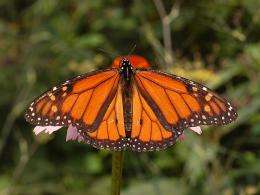New study confirms that migration leads to larger wings in monarch butterfly populations

How migration boosts the size of monarch butterflies?
The migration of monarch butterflies in eastern North America is without question one of the greatest spectacles of nature – each fall, millions of the insects travel thousands miles to reach their overwintering destination in Mexico, where they drape the trees in clusters of hundreds of thousands. How they accomplish this amazing feat has been the subject of much research over the years, and researchers have often honed in on the wing designs of migrant monarchs. Most prior work has indicated that a key element of their success appears to be the physical structure of their wings, specifically, their size, and that is the subject of a new research paper just published by De Gruyter Open in the online journal, Animal Migration.
The new study builds on a certain previous analysis that had shown migratory populations of monarchs tend to have larger wings than non-migratory populations, suggesting that migration acts to keep monarchs large. However, in that study the butterflies that had the smallest wings tended to be closer to the earth's equator. This left open the possibility that the populations differed because of Bergmann's rule, which is a general principle throughout the animal kingdom whereby animals living closer to the equator (with warmer climate) tend to be smaller than those living in colder locations away from the equator. To sort out which of these two possibilities is the cause of the wing variation, a group of researchers from Emory University in Atlanta, GA examined a larger collection of monarchs from around the globe and compared wing features of each population, migratory and non-migratory. They also looked for evidence that the wings corresponded to the latitude of the population, which would support Bergmann's rule.
In the end the researchers found no evidence that the wing differences followed Bergmann's rule, and instead they concluded that the main driver of the population differences was indeed the migration, as was found in the earlier work. It seems that the long-distance journey acts to weed out smaller monarchs each year, leaving only the biggest ones, which then go on to reproduce. In monarch populations that are sedentary, this selection does not happen.
According to Dr. Lincoln Brower from the Sweet Briar College, a national expert in monarch biology, "This was a very well-organized study and the data were quite clear"
"I was personally very excited to see the results from this project," says Andy Davis, Editor-in-Chief of the journal, a noted expert on monarch butterflies himself. "This study effectively demonstrates how important the monarch migration is in shaping, quite literally, the physical features of North American monarchs. With all of the recent news about the decline of the monarch migration, this makes studies like these all the more important."
More information: Yiwen Li et al. Variation in Forewing Size Linked to Migratory Status in Monarch Butterflies, Animal Migration (2016). DOI: 10.1515/ami-2016-0003
Provided by De Gruyter

















